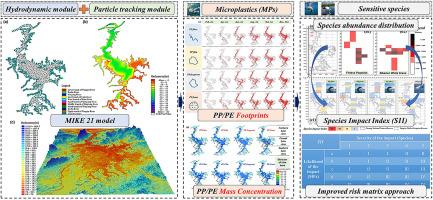从颗粒跟踪建模到物种影响预测:中国最大淡水湖微塑料暴露风险量化框架
IF 7.3
2区 环境科学与生态学
Q1 ENVIRONMENTAL SCIENCES
引用次数: 0
摘要
微塑料(MPs)是研究最广泛的污染物之一,但在水生环境中使用数值模拟对其运输途径和质量浓度进行了相对较少的探索。利用水动力学模型和粒子跟踪模块,研究了鄱阳湖中悬浮微粒的运移动力学、空间分布和影响程度。采用改进的风险矩阵法半定量评价了MPs对江豚和西伯利亚白鹤的物种影响指数。研究表明,PA/PVC颗粒大部分滞留在主盆地外,而PP/PE颗粒进入中心湖具有形状和密度相关的滞后时间。PE比PP沉降更快,滞留时间更长,高表面积形态(如纤维、薄膜)通过生物膜介导的密度增加加速沉降。在复杂的水深和水动力学的驱动下,在容易重沉的区域发生了空间异质性的MP积累。结果表明,MP足迹与敏感物种的关键生境存在明显的空间重叠,其中PP/PE纤维和泡沫在北部和西南亚区构成III级(显著)风险。根据评价结果,对鄱阳湖浮游生物的管理和控制提出了有针对性的建议,为湖泊管理者提供了保护框架。本文章由计算机程序翻译,如有差异,请以英文原文为准。


From particle tracking modelling to species impact forecasting: a framework for microplastic exposure risk quantification in the largest freshwater lake of China
Microplastics (MPs) are among the most widely studied pollutants, yet their transport pathways and mass concentrations have been relatively unexplored using numerical modelling in aquatic environments. In this study, we investigated the transport dynamics, spatial distribution, and impact levels of MPs in Poyang Lake, China's largest freshwater lake, utilizing a hydrodynamic model coupled with the particle tracking module. An improved risk matrix approach was applied to semi-quantitatively assess the Species Impact Index () of MPs on Finless Porpoises and Siberian White Cranes. This study showed that PA/PVC particles were largely retained outside the main basin, while PP/PE particles entered the central lake with shape- and density-dependent lag times. PE settled faster and exhibited longer retention than PP, with high-surface-area morphotypes (e.g., fibres, films) accelerating sedimentation through biofilm-mediated density increase. Spatially heterogeneous MP accumulation occurred in resuspension-prone regions driven by complex bathymetry and hydrodynamics. results indicated significant spatial overlap between MP footprints and critical habitats of the sensitive species, with PP/PE fibres and foams posing Grade III (significant) risks in northern and southwestern subregions. Based on the evaluation results, targeted recommendations were proposed for the management and control of MPs in Poyang Lake, providing a protective framework for lake administrators.
求助全文
通过发布文献求助,成功后即可免费获取论文全文。
去求助
来源期刊

Environmental Pollution
环境科学-环境科学
CiteScore
16.00
自引率
6.70%
发文量
2082
审稿时长
2.9 months
期刊介绍:
Environmental Pollution is an international peer-reviewed journal that publishes high-quality research papers and review articles covering all aspects of environmental pollution and its impacts on ecosystems and human health.
Subject areas include, but are not limited to:
• Sources and occurrences of pollutants that are clearly defined and measured in environmental compartments, food and food-related items, and human bodies;
• Interlinks between contaminant exposure and biological, ecological, and human health effects, including those of climate change;
• Contaminants of emerging concerns (including but not limited to antibiotic resistant microorganisms or genes, microplastics/nanoplastics, electronic wastes, light, and noise) and/or their biological, ecological, or human health effects;
• Laboratory and field studies on the remediation/mitigation of environmental pollution via new techniques and with clear links to biological, ecological, or human health effects;
• Modeling of pollution processes, patterns, or trends that is of clear environmental and/or human health interest;
• New techniques that measure and examine environmental occurrences, transport, behavior, and effects of pollutants within the environment or the laboratory, provided that they can be clearly used to address problems within regional or global environmental compartments.
 求助内容:
求助内容: 应助结果提醒方式:
应助结果提醒方式:


